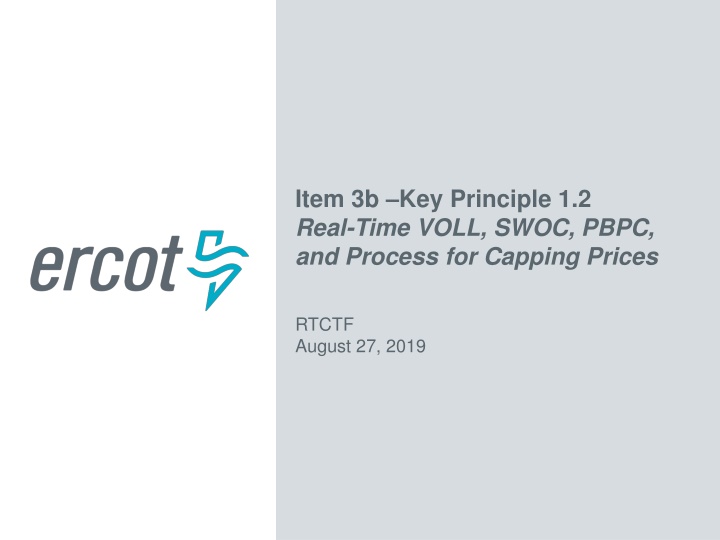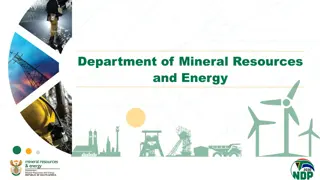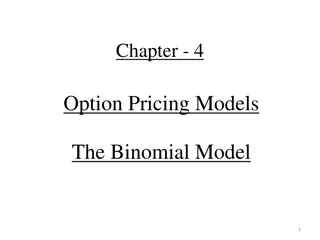Real-Time Pricing Strategies and Value Optimization
Explore key principles including Real-Time VOLL, SWOC, PBPC, and the process for capping prices. Learn about acronyms, introduction to PUCT direction, and SWOC/VOLL parameters for energy pricing. Gain insights into how prices are capped and adjusted based on system conditions.
Download Presentation

Please find below an Image/Link to download the presentation.
The content on the website is provided AS IS for your information and personal use only. It may not be sold, licensed, or shared on other websites without obtaining consent from the author.If you encounter any issues during the download, it is possible that the publisher has removed the file from their server.
You are allowed to download the files provided on this website for personal or commercial use, subject to the condition that they are used lawfully. All files are the property of their respective owners.
The content on the website is provided AS IS for your information and personal use only. It may not be sold, licensed, or shared on other websites without obtaining consent from the author.
E N D
Presentation Transcript
Item 3b Key Principle 1.2 Real-Time VOLL, SWOC, PBPC, and Process for Capping Prices RTCTF August 27, 2019
Acronyms Ancillary Service (AS) Ancillary Service Demand Curves (ASDC) ERCOT Contingency Reserve Service (ECRS) Key Principle (KP) Market Clearing Price for Capacity (MCPC) Non-Spinning Reserve Service (Non-Spin) Peaker Net Margin (PNM) Power Balance Penalty Price (PBPP) Power Balance Penalty Curve (PBPC) Public Utility Commission of Texas (PUCT) Real-Time Co-optimization (RTC) Real-Time Co-optimization Task Force (RTCTF) Real-Time Market (RTM) Regulation Down Service (Reg-Down) Regulation Up Service (Reg-Up) Responsive Reserve Service (RRS) System-Wide Offer Cap (SWOC) 2 PUBLIC
Introduction In addition to the PUCT providing direction on the process for developing the ASDCs, there was also direction that allows the RTCTF to move forward on the following KP 1.1 and 1.2 items from the tracking spreadsheet: New value for the SWOC; New value and shape for the PBPC; and Elimination of the ORDC price adders. There were also other items in Chair Walker s memo that seem to fit naturally into these two KPs (E.g., the capping of prices, exclusive of congestion cost). 3 PUBLIC
SWOC and the Value of Lost Load (VOLL) For the period of the annual Resource adequacy cycle where the PNM threshold has not been met, the following parameters will be in effect: SWOC will be equal to $2,000/MWh; VOLL will be equal to $9,000/MWh, which results in the maximum ASDC value also being set at $9,000/MWh; The energy price, exclusive of congestion costs, produced every execution of the RTM (i.e., System Lambda) will be capped at $9,000/MWh; and A PBPP replaced the current PBPC and will be equal to $11,000.01/MWh. This choice is driven by SWOC and maximum ASDC values Similar to today with $9,001/MWh on the PBPC, the value should be something slightly higher than $11,000/MWh If capping process affects the energy price, similar adjustment are needed for the AS MCPCs. 4 PUBLIC
SWOC and VOLL When reserves are below 2,000 MW: System Lambda would be between $9,000/MWh and $11,000/MWh depending on the energy offer price of the marginal Resource. Prices would be capped ex post at $9,000/MWh, such that congestion pricing differentials would be maintained but the energy price at the distributed load reference (System Lambda) would be $9,000/MWh instead of the initial value of $9,000- $11,000/MWh. The adjustment could be as much as $2,000/MWh 11000 10000 9000 8000 7000 6000 5000 4000 3000 2000 1000 0 3750 6750 250 500 750 1000 1250 1500 1750 2000 2250 2500 2750 3000 3250 3500 4000 4250 4500 4750 5000 5250 5500 5750 6000 6250 6500 7000 7250 7500 7750 8000 0 5 PUBLIC
SWOC/VOLL and Adjusting MCPCs Note: The discussion for adjusting MCPCs in this presentation excludes Reg-Down. If System Lambda is reduced during the capping, a subset of the AS MCPCs would also need to be adjusted. Example of why this is the case (and assuming no transmission congestion): Resource 1 is available for both real-time energy dispatch and AS awards with an energy offer of $40/MWh and an RRS offer of $0/MWh. The system is in scarcity condition and the ASDC for RRS sets the RRS price at $9,000/MWh. If Resource 1 is the marginal Resource for energy and is awarded RRS, the System Lambda from the optimization will be $9,040/MWh. If the energy price is lowered from $9,040/MWh to $9,000/MWh and the RRS price remains at $9,000/MW, Resource 1 is no longer indifferent to providing energy and RRS. 6 PUBLIC
SWOC/VOLL and Adjusting MCPCs From the optimization: Capping energy only: Capping energy only and adjusting MCPCs: For energy, the spread between adjusted price and offer-based cost is still $8,960/MWh ($9,000/MWh - $40/MWh). For energy, the spread between price and offer- based cost is $9,000/MWh ($9,040/MWh - $40/MWh). For energy, the spread between adjusted price and offer-based cost becomes $8,960/MWh ($9,000/MWh - $40/MWh). For RRS, the spread between price and offer- based cost is also $9,000/MWh ($9,000/MWh - $0/MWh). For RRS, the price is also adjusted and the spread between adjusted price and offer-based cost is now $8,960/MWh ($8,960/MWh - $0/MWh). For RRS, the spread between price and offer- based cost remains at $9,000/MWh ($9,000/MWh - $0/MWh). Resource would rather have been awarded more RRS Resource is again indifferent Resource is indifferent While only $40/MWh in this case, the adjustment could theoretically be as high as $2,000/MWh. I.e., this could mean an AS MCPC adjustment from $9,000/MWh down to $7,000/MWh. 7 PUBLIC
SWOC/VOLL and Adjusting MCPCs The MCPC adjustment may have to be applied to multiple AS products to maintain this indifference for Resources, including AS products where the ASDC is not setting the AS MCPC. Showing an example of this conditions using the RTC Automated Scenario Analysis spreadsheet (7-22-19 version) Use all the default settings and parameters, except change the Demand value in cell B23 to 60,800 MW and click solve Don t forget to select Enable Content and ensure the Solver Add-In in Excel is enabled. 8 PUBLIC
SWOC/VOLL and Adjusting MCPCs Using a demand of 60,800 MW and not capping any prices, the solver produces the following results: When System Lambda ( Energy in the spreadsheet) is capped at $9,000/MWh and RRS is originally priced at $9,000/MWh, the need to adjust the RRS MCPC was just discussed. Again, the example is that the RRS MCPC must to be adjusted to $8,960/MWh to keep the marginal Resource indifferent ( G3 in the spreadsheet) 9 PUBLIC
SWOC/VOLL and Adjusting MCPCs However, a similar concern exists for Reg-Up. In the case of Reg-Up, it s the opportunity cost of Resource G7 that is setting the MCPC of $8,980/MWh. If the MCPC for Reg-Up is not also adjusted by the same $40/MWh ($9,040/MWh - $9,000/MWh) G7 would have preferred to provide more Reg- Up than energy, given the energy and AS offers for the Resource. This is corrected by adjusting the MCPC from $8,980/MWh to $8,940/MWh. The MCPC adjustment is particularly relevant for any AS products that are still be awarded during these intervals. 10 PUBLIC
SWOC/VOLL and Adjusting MCPCs In the way the ASDCs have been defined for the RTC Automated Scenario Analysis spreadsheet (7-22-19 version), this same concern does not exist for ECRS and Non-Spin. With the maximum ASDC values for ECRS and Non-Spin, those AS products are no longer being awarded to any of the Resources in the system when the energy price is being capped. I.e., there are no Resources that need to be kept indifferent between energy and AS with the price adjustments. Even so, there are other considerations. These considerations are more apparent in the next case where the PNM threshold has been reached. 11 PUBLIC
Value Changes After the PNM Threshold is Met For the period of the annual Resource adequacy cycle where the PNM threshold has been met, the following parameters will be in effect: SWOC will still be equal to $2,000/MWh; VOLL will be equal to $2,000/MWh, which results in the maximum ASDC value also being set at $2,000/MWh; The energy price, exclusive of congestion costs, produced every execution of the RTM (i.e., System Lambda) will be capped at $2,000/MWh; and PBPP will be equal to $4,000.01/MWh. This choice is again driven by SWOC and maximum ASDC values Again, if capping process affects the energy price, similar adjustments are needed for the AS MCPCs. Thinking about how to adjust MCPCs for those AS products not being awarded to any of the Resources is more complicated with the lower VOLL and cap values. 12 PUBLIC
Value Changes After the PNM Threshold is Met When reserves are below 2,000 MW: System Lambda would be between $2,000/MWh and $4,000/MWh depending on the energy offer price of the marginal Resource. Prices would be capped ex post at $2,000/MWh, such that congestion pricing differentials would be maintained but the energy price at the distributed load reference (System Lambda) would be $2,000/MWh instead of the initial value of $2,000 -$4,000/MWh. Again, this could mean an adjustment of as much $2,000/MWh 4000 3500 3000 11000 2500 10000 9000 2000 8000 7000 1500 6000 5000 1000 4000 3000 2000 500 1000 0 0 750 5000 6250 250 500 1000 1250 1500 1750 2000 2250 2500 2750 3000 3250 3500 3750 4000 4250 4500 4750 5250 5500 5750 6000 6500 6750 7000 7250 7500 7750 8000 0 13 PUBLIC
SWOC/VOLL and Adjusting MCPCs With the need to adjust energy prices by as much as $2,000/MWh, this means that at least some MCPCs would also need to be adjusted by $2,000/MWh With the maximum value on the ASDCs being $2,000/MWh, that would result in AS MCPCs at or near $0/MWh. If MCPC adjustments are limited to only those AS products that are still being awarded at this level of scarcity, we would most likely see Reg-Up and RRS MCPCs being set to $0/MWh with ECRS and Non-Spin MCPCs in the $100/MWh to $1000/MWh range This would mean AS imbalance charges for ECRS and Non-Spin, but not for Reg- Up and RRS To address this disparity, we re proposing to adjust all AS MCPCs by the same amount while applying a floor of $0/MWh to ensure that no MCPCs become negative. 14 PUBLIC
SWOC/VOLL and Adjusting MCPCs From a formula point of view, these adjustment will look like: 1. Adjusted System Lambda = Min (Original System Lambda, 9000) 2. MCPC Adjustment Factor = Original System Lambda Adjusted System Lambda 3. Adjusted Reg-Up MCPC = Max (Original Reg-Up MCPC - MCPC Adjustment Factor, 0) 4. Adjusted RRS MCPC = Max (Original RRS MCPC - MCPC Adjustment Factor, 0) 5. Adjusted ECRS MCPC = Max (Original ECRS MCPC - MCPC Adjustment Factor, 0) 6. Adjusted Non-Spin MCPC = Max (Original Non-Spin MCPC - MCPC Adjustment Factor, 0) 15 PUBLIC
Draft Key Principle Concepts Previously Shared KP1 The ORDC prices adders and the associated process of determining those price adders in real-time are eliminated under RTC. Instead, the RTM optimization will use ASDCs as input and determine MCPCs for each of the individual AS products. KP2 For the period of the annual Resource adequacy cycle where the PNM threshold has not been met, the following parameters will be in effect: SWOC will be equal to $2,000/MWh; VOLL and the maximum ASDC value will be equal to $9,000/MWh; The energy price, exclusive of congestion costs, produced every execution of the RTM will be capped at $9,000/MWh; and PBPP will be equal to $11,000.01/MWh. After the PNM threshold has been met, a process will be used to adjust the parameters to be: SWOC will be equal to $2,000/MWh; VOLL and the maximum ASDC value will be equal to $2,000/MWh; The energy price, exclusive of congestion costs, produced every execution of the RTM will be capped at $2,000/MWh; and PBPP will be equal to $4,000.01/MWh. 16 PUBLIC
Draft Key Principle Concepts New KP2 For instances in which the energy price, exclusive of congestion costs, has been reduced to ensure that the final value does not exceed VOLL, the MCPCs for Reg- Up, RRS, ECRS, and Non-Spin will be adjusted by the same $/MWh amount with a floor on the final MCPCs of $0/MWh. 17 PUBLIC























